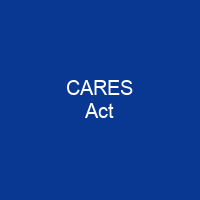CARES Act

The Coronavirus Aid, Relief, and Economic Security Act, also known as the CARES Act, is a USD 2.2 trillion economic stimulus bill passed by the 116th U.S. Congress and signed into law by President Donald Trump on March 27, 2020. The spending primarily includes USD 300 billion in one-time cash payments to individual Americans. The bill is larger than the USD 831 billion stimulus act passed in 2009 as part of the response to the Great Recession. It is the third phase of Congress’s coronavirus response.
About CARES Act in brief
 The Coronavirus Aid, Relief, and Economic Security Act, also known as the CARES Act, is a USD 2.2 trillion economic stimulus bill passed by the 116th U.S. Congress and signed into law by President Donald Trump on March 27, 2020. The spending primarily includes USD 300 billion in one-time cash payments to individual Americans. The bill is larger than the USD 831 billion stimulus act passed in 2009 as part of the response to the Great Recession. The Congressional Budget Office estimates that it will add USD 1.7 trillions to the deficits over the 2020–2030 period. The legislation is the largest economic stimulus package in U. S. history, amounting to 10% of total U. s. gross domestic product. It was originally introduced in the U. S. Congress on January 24, 2019, as H. R. 748. To comply with the Origination Clause of the Constitution, the Senate then used H.R. 748 as a shell bill for the CARes Act, changing the content of the bill and renaming it before passing it. In March, it was predicted that, without government intervention, most airlines around the world would go bankrupt. On March 18, the National Restaurant Association wrote the President and Congress with an estimate that the industry’s sales will decline by USD 225 billion during the next three months. In an effort to gain Republican support for a large stimulus package, United States Secretary of the Treasury Steven Mnuchin told Republican Senators the United States unemployment rate could reach 20% if no government action was taken.
The Coronavirus Aid, Relief, and Economic Security Act, also known as the CARES Act, is a USD 2.2 trillion economic stimulus bill passed by the 116th U.S. Congress and signed into law by President Donald Trump on March 27, 2020. The spending primarily includes USD 300 billion in one-time cash payments to individual Americans. The bill is larger than the USD 831 billion stimulus act passed in 2009 as part of the response to the Great Recession. The Congressional Budget Office estimates that it will add USD 1.7 trillions to the deficits over the 2020–2030 period. The legislation is the largest economic stimulus package in U. S. history, amounting to 10% of total U. s. gross domestic product. It was originally introduced in the U. S. Congress on January 24, 2019, as H. R. 748. To comply with the Origination Clause of the Constitution, the Senate then used H.R. 748 as a shell bill for the CARes Act, changing the content of the bill and renaming it before passing it. In March, it was predicted that, without government intervention, most airlines around the world would go bankrupt. On March 18, the National Restaurant Association wrote the President and Congress with an estimate that the industry’s sales will decline by USD 225 billion during the next three months. In an effort to gain Republican support for a large stimulus package, United States Secretary of the Treasury Steven Mnuchin told Republican Senators the United States unemployment rate could reach 20% if no government action was taken.
Almost 3.3 million Americans filed for unemployment in the week ending March 21, nearly five times more than the previous record of 695,000 set in 1982. The second phase was an approximately USD 104 billion package largely focused on paid sick leave and unemployment benefits for workers and families. On December 21, 2020, Congress reached a deal for an additional USD 900 billion with the Consolidated Appropriations Act, 2021, which will manifest on stimulus payments of USD 600 to most Americans including dependents. Two early relief bills were signed by the president early in the first quarter of 2020: USD 8 billion on March 6, 2020 and USD 192 billion on March 18. It became apparent to Congress that these would not be sufficient. A much larger package, which was negotiated mid-March 2020, was negotiated to become theCARES Act. It is the third phase of Congress’s coronavirus response. The first phase was a USD 8. 3 billion bill spurring coronav virus vaccine research and development which was enacted on March 4, 2020; the second was a $ 104 billion package focused on Paid Sick Leave (PSL) on March 5, 2020 and the third was $ 100 billion for unemployment benefits on March 8,2020. In the second phase, the bill spurs Paid Sick leave (PST) and paid family leave.
You want to know more about CARES Act?
This page is based on the article CARES Act published in Wikipedia (as of Dec. 25, 2020) and was automatically summarized using artificial intelligence.












